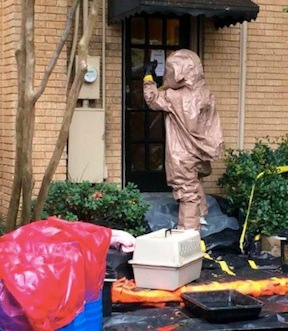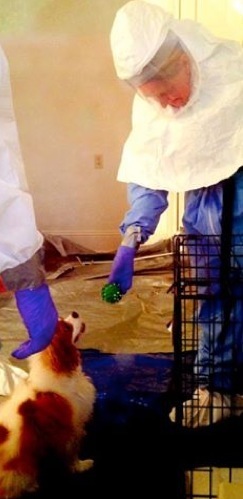Below is an article that I found very informative. I think you will too! Dr. Flatley
 Dog under Ebola watch gets High-Level Caretakers
Dog under Ebola watch gets High-Level Caretakers
Photo courtesy of Dallas Animal Services
Dallas city officials promised to take care of Bentley while his owner,
Nina Pham, is being treated for Ebola infection. Although almost nothing
is known about the role of dogs in the transmission of the Ebola virus,
the Cavalier King Charles spaniel is in quarantine on the chance that
he could pass on the virus.“When he goes home happy and healthy,” Davis said, “then people can see it’s not a big deal.
Bentley,
the spaniel belonging to Ebola patient Nina Pham, is living in a former
military commander’s house on an inactive naval air field in Dallas,
tended two to three times a day by a team of veterinarians from Texas
A&M University, including an expert in infectious diseases with
experience in Ebola research.
As the pet of the first person to
contract Ebola in the United States, Bentley is the focus of special
attention. No one knows whether dogs can get sick from or transmit the
Ebola virus to people. How officials handle the unknown risk is under
public scrutiny in light of an
unpopular decision by the government of Madrid earlier this month to euthanize the dog of a sick nurse in Spain.
The
city of Dallas pledged a different approach with Pham’s dog, a
1-year-old Cavalier King Charles spaniel. “As our brave health-care
worker told us, this dog is a significant part of her life, and we vowed
to her family we would do everything in our power to care for her
beloved pet,” Dallas Mayor Mike Rawlings said in a
press release last week.
Pham
became infected with Ebola as a nurse at Texas Health Presbyterian
Hospital caring for Thomas Eric Duncan, who caught the disease in his
native Liberia shortly before visiting the United States. Duncan died on
Oct. 8.
Since then, an ever-widening circle of people may have
been exposed to Ebola by other members of Duncan’s medical team. The
prospect of monitoring a growing population raises a host of logistical
questions, including the safest and smartest way to care for the pets of
Ebola patients. The problem is that almost nothing is known about
Ebola’s effects, if any, on companion animals.
Dr. Radford Davis,
an associate professor of public health at Iowa State University
College of Veterinary Medicine and an authority on diseases that
transmit between people and other animals, doubts many other pets would
command the same attention as Bentley.
“If you have a dog and you
come down with Ebola, and now it’s going to high-containment quarantine
like they’re doing in Texas, that’s a big deal,” Davis said. “It’s a
lot of money; a lot of effort. How many people are they going to do that
for? How many dogs?”
A group of veterinary infectious and zoonotic disease experts coordinated by the
U.S. Centers for Disease Control and Prevention and the
American Veterinary Medical Association is working on guidelines for Ebola quarantines of pets, chiefly dogs and cats.
There
is no evidence that dogs and cats are capable of transmitting Ebola
virus. At the same time, there’s no definitive evidence that they can’t.
For that reason, “While it’s very unlikely they are a realistic source
of infection, prudence dictates that we consider it possible until we
know that it isn’t,” said Dr. J. Scott Weese, a member of the group
developing the guidelines. Weese is chief of infection control at the
University of Guelph’s Ontario Veterinary College and Canada Research
Chair in zoonotic diseases.
While a variety of details in the
guidance remain to be hashed out, Weese said he expects that
general-practice veterinarians with private clinics won’t be called upon
to care for animals under an Ebola watch.
“I don’t think most
practices have the facilities or the time, and there’s an expense. I’m
not sure who’s going to pay for it,” Weese said. “From a business
standpoint, most vets probably are not going to want their clients
worrying about Ebola in their clinic.”
The likelier scenario, he
said, is that animals needing to be monitored would be put in the care
of institutions that have facilities dedicated to infection control.
“Mostly, I suspect it will be university settings or temporary
facilities,” Weese said. “You don’t need a fancy facility. You just need
a secure facility away from other people and animals. You need an area
that’s secure on multiple levels. One in which you can humanely take
care of the animals, and with areas for taking on and off protective
equipment. …
“Once you start sketching out how you do it, you realize how complex it is,” he said.
Major mobilization for Bentley
In
Dallas, the city, county, state and private funders are contributing to
the cost of Bentley’s care, according to C.C. Gonzalez-Kurz, a city
spokeswoman. “The process of his care has not been completed and is very
fluid, so a total cost is unknown at this time,” she said late last
week.

Photo courtesy of Dallas Animal Services
Bentley was removed from his home in an apartment building on Oct. 13 by
hazardous-material-cleanup contractors, and transported in a city
animal control truck to Hensley Field, an inactive military site owned
by the city of Dallas.
Dr.
Catherine “Cate” McManus, director of operations at Dallas Animal
Services, is coordinating Bentley’s veterinary care, although the city
won’t allow her to handle the dog or enter the building where he’s kept,
to her disappointment. The city’s concern is “just the unknown,” she
said in an interview.
With a master’s degree in public health,
board certification in preventive medicine, experience as a veterinary
epidemiologist in Virginia, and service in the U.S. Army Veterinary
Corps, McManus is undaunted by her role in the Ebola crisis.
Bentley’s
owner was admitted to the hospital on Oct. 11, a Saturday; her dog was
taken out of her home two days later. Leading up to the move, McManus
said, “There were a lot of decisions and communications going on between
the city, state and federal government about how to move him, where to
move him to and how we’re going to handle him for the 21-day
quarantine.”
McManus would have liked to keep him in his home,
but that wasn’t possible because it is an apartment building. “Our
mission (that) Monday morning was finding a place for him to go,” she
recounted. “We were trying to think of city resources, and what I’ve
typically done with disaster response is use an old warehouse.”
Officials
settled upon Naval Air Station Dallas, also known as Hensley Field,
city property that once served as a training site for reserve pilots.
“We saw these houses, and we were like, ‘Well, what about the house?’ ”
McManus said, referring to commander and executive officer residences.
She said the homes are “beautiful” and weren’t in use.
The house
they chose lends itself to being partitioned into zones. The “hot” zone
where Bentley is kept is the kitchen. The adjacent dining room is the
“warm” zone where handlers don and doff personal protective equipment.
“We
tarped everything down, really to protect the floors more than
anything, and set up two crates,” McManus said. “We have one crate
that’s ready for him, and when we go to clean, we shift him into the
clean crate, to try to have as minimal handling as possible.”
Trying not to touch the playful, fluffy, tan-and-white dog is hard, she said, because “he’s so darned cute.”
The
people directly caring for Bentley come from Texas A&M University,
led by Dr. Tammy Beckham, director of the Institute for Infectious
Animal Diseases. According to her
biography,
Beckham is a former U.S. Army captain who served at the Army’s Medical
Research Institute for Infectious Diseases in Frederick, Maryland, where
she worked with Ebola and related viruses. She also served as a
director of the Foreign Animal Disease Diagnostic Laboratory, a part of
the U.S. Department of Agriculture’s Plum Island Animal Disease Center
in New York.
Also on Bentley’s case is the university’s
Veterinary Emergency Team, which describes itself as “the largest and most sophisticated veterinary medical disaster response team in the country.”

Photo courtesy of Dallas Animal Services
Veterinarians in protective garb feed, clean up after and visit with
Bentley two to three times a day. Dallas Animal Services posts frequent
updates about Bentley on its Facebook page.
The veterinarians play with Bentley as best they can. One of many photos of Bentley posted on Dallas Animals Services’
Facebook page
shows someone in a biohazard suit, with face mask and gloves, holding
out a green ball to the little dog. Another shows the dog snuggled
against Beckham.
“He has been petted and played with squeaky
toys,” McManus reported. His appetite is good, he’s got a radio tuned to
a classical-music station and the care team is aiming to rig a bigger
crate for him, she added. “Fortunately, he’s a good dog and is easy to
take care of.”
To monitor his health, the team hasn’t been taking
his temperature daily, just watching his behavior and making sure he
eats, drinks and relieves himself regularly, she said.
On Sunday,
the city announced that starting today and for the remainder of his
quarantine, Bentley's urine and feces will be collected three times for
testing. “This is the least invasive and safest way to conduct the
testing process for Bentley,” a press release states.
Very little known about Ebola in pets
Although the purpose of quarantining Bentley is to watch for signs of Ebola, no one knows what those are in a dog.
Only one scientific
study has focused on Ebola in dogs. In that study, published in the
Journal of Emerging Infectious Diseases
in 2005, African and French researchers observed that during an
outbreak in Gabon in 2001 and 2002, some dogs fed on the carcasses of
infected animals. Analyzing dogs from the affected area, the researchers
found antibodies in the blood of about 25 percent of the animals, but
not the virus itself.
Weese, the infectious and zoonotic disease expert from Ontario Veterinary College, noted recently in an
article in
Clinician’s Brief, “This situation is
profoundly different than that of a household pet with transient exposure to a human that has been exposed or has early infection.”
The
findings indicate that dogs have an immune response to Ebola but
whether the virus may cause clinical illness in dogs is unknown. It’s
also unknown whether an exposed dog that’s not sick can transmit the
virus to people. Weese said he thinks it unlikely.
Still, there are pathogens that pets showing no signs of distress may still transmit to people. Examples are
Salmonella and the fungus that causes ringworm.
The
lack of knowledge about Ebola and pets doesn’t give decision-makers
much to go on, so they need to be cautious, said Weese. “We have a
limited concern that dogs are a source. We can’t say no, so we have to
say maybe,” he said.
With cats, the picture is murkier still. No one has studied cats and Ebola.
The
host of unknowns makes Ebola particularly fearsome, even compared with a
nearly 100-percent-lethal disease such as rabies. Rabies looks
manageable compared with Ebola because vaccines exist and it’s possible
to prevent infection in an exposed person with quick action.
Moreover,
Weese pointed out: “We know how rabies is transmitted: a bite or
scratch (allowing) inoculation of infected saliva into the body. We know
when rabies-infected animals can transmit the virus. With Ebola, we
don’t know if dogs can shed the virus, if they are always clinically ill
when shedding the virus, whether there’s a risk of aerosol transmission
and (what are) optimal infection control practices.”
But Ebola
isn’t indomitable. Weese describes it as a “wimpy enveloped virus.” The
envelope is an outer fatty layer that’s susceptible to damage when
exposed to the open air or in contact with disinfectant.
Non-enveloped
viruses are much hardier, resistant to heat, acids and drying, and able
to remain infective even after drying. An example is norovirus, the
very contagious pathogen that causes stomach and intestinal upset. Weese
said norovirus can survive for a week outside the body.
Ebola
also doesn’t appear to affect a wide variety of species — mainly bats,
humans and some non-human primates. “If it was found in a lot of
species, we’d have a lot more concerns about dogs,” Weese said.
While
keeping Ebola-exposed pets in quarantine could be an opportunity to
learn more about how the virus behaves in companion animals, Weese said
regularly examining animals in confinement could be problematic. “You
don’t want to get bitten or scratched,” he explained. “The goal is
minimizing exposure. … If the animal’s sick and we need to draw blood,
it’s going to be (with the animal) under anesthesia.”
Considering
all the unknowns about pets and Ebola, Davis, the public health
professor at Iowa State, said quarantine protocols will be based on
extrapolating from what we know in humans. For example, the 21-day
confinement period comes from the incubation period of the virus in
people. That may or may not be the same in dogs and cats, assuming
there’s an incubation period at all.
“The guidelines are going to
have to walk the line between what the evidence shows and what’s
prudent and not burdensome,” Davis said.
One aspect to consider,
Weese said, is how to prevent the need for a pet’s quarantine at all.
Pet owners who are being monitored but aren’t sick might consider having
someone else care for their pets, if possible, until their own
quarantine is over, he suggested. That way, were an owner to become ill,
the pet won’t have been exposed and won’t need to be confined.
Believing
the risk of dogs transmitting Ebola to be exceedingly small, Davis said
he looks forward to the day that Bentley is released. He will have been
in quarantine for 21 days on Nov. 3.
October 20, 2014
By: Edie Lau
Copied from The Veterinary Information Network News Service
 With Christmas just a few weeks away, life can be crazy in December. As special as Christmas is, this
With Christmas just a few weeks away, life can be crazy in December. As special as Christmas is, this  I recommend Feliway for a variety of stressful situations: travel (to the vet), new baby, remodeling, moving, new pet, and especially holidays. It also works well in the treatment of territorial aggression and urine marking. It is simple to use, and will really make a difference in your cats happiness!
I recommend Feliway for a variety of stressful situations: travel (to the vet), new baby, remodeling, moving, new pet, and especially holidays. It also works well in the treatment of territorial aggression and urine marking. It is simple to use, and will really make a difference in your cats happiness! I recommend Feliway for a variety of stressful situations: travel (to the vet), new baby, remodeling, moving, new pet, and especially holidays. It also works well in the treatment of territorial aggression and urine marking. It is simple to use, and will really make a difference in your cats happiness!
I recommend Feliway for a variety of stressful situations: travel (to the vet), new baby, remodeling, moving, new pet, and especially holidays. It also works well in the treatment of territorial aggression and urine marking. It is simple to use, and will really make a difference in your cats happiness!















